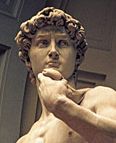 What does one of history’s greatest artists have in common with people today who want to change their lives? The Michelangelo Method sees Michelangelo as a model for looking within, overcoming obstacles, and sculpting a more creative, authentic life. There is little doubt that Michelangelo was one of history’s greatest sculptors, a man who could transform a solid block of marble into lifelike form that married classical proportion and technique with a passionate expressionism that had never been seen before in sculpture. But even considering his genius, how could Michelangelo carve the David from a giant block of stone that was so damaged that his contemporaries considered it "ruined" and "a thing of no value"?
What does one of history’s greatest artists have in common with people today who want to change their lives? The Michelangelo Method sees Michelangelo as a model for looking within, overcoming obstacles, and sculpting a more creative, authentic life. There is little doubt that Michelangelo was one of history’s greatest sculptors, a man who could transform a solid block of marble into lifelike form that married classical proportion and technique with a passionate expressionism that had never been seen before in sculpture. But even considering his genius, how could Michelangelo carve the David from a giant block of stone that was so damaged that his contemporaries considered it "ruined" and "a thing of no value"?
The answer is simple. Michelangelo looked at the block and saw his David locked inside.
Michelangelo held an important belief about the art of sculpture. He believed that in each block of stone there was a figure hidden inside, waiting to be revealed. To Michelangelo, the master sculptor’s job was to clear away what was not the image and reveal the masterpiece inside the stone.
In addition, Michelangelo's chief value—what he cared about most—was to glorify God. He believed that man was created in God's image and that in rendering God's highest creation as perfectly as possible, he was glorifying God. For Michelangelo's creativity to be released, it had to be aligned with this deeply held value.
This amazing principle applies to all of us. To find your masterpiece, the life you were meant to live, you must look inside. It’s there, waiting for you to clear away all that is not you—the fears, beliefs, and wishes that others have imposed on you, the negative stories you tell about yourself, the defeatist attitude toward overcoming obstacles to your vision.
Susan Finds Her Gift
Like the damaged stone from which Michelangelo’s David was carved, Susan beheld what she considered to be her ruined life and the empty years that lay ahead of her. For the past sixteen years, she had been a hard-working single mother, juggling a demanding career and taking care of her daughter without any help from the child’s chronically absent father. To make her life more challenging, Susan was ambitious for herself and her daughter, and over the years pushed herself to keep more and more balls in the air. Every year, she would take on more work, more community service, more professional development classes, while tutoring her daughter at home after work and making sure she knew what was going on at school. Susan was a master juggler, but her busy schedule took a toll.
Susan worked as a legal assistant for a major law firm. Her daughter, “the flower from my compost heap of a marriage” as she put it, had recently left for college on an academic scholarship. With her daughter launched, Susan was left to consider her own path. She looked down at the ground below her. "Dull cement," she said, "and my feet were planted in it long before I had a chance to choose."
Susan wanted a change. She was dying for a change. But to what? She had no idea. And wasn’t it too late already? After all, she was nearly forty-two. Susan couldn’t think constructively. She believed that she had no choices. Here was a bright, articulate, capable woman who, in her own mind, could never do anything right and believed she had missed her chance anyway. Susan thought her life nothing more than a giant “might have been.” If she hadn’t married so young, she might have had a relationship she was happy with. If she hadn’t gotten pregnant, she might have finished law school. If she had finished law school, she could have been the lawyer and not the legal assistant. Susan couldn’t figure out where to begin. Her early enchantment with the law had faded. She wanted a new life, and her greatest fear was, to paraphrase Oliver Wendell Holmes, that she might die with her music still in her. For Susan, it was time to start playing her own music.
Working with a life coach, Susan asked, "How do I find out what exactly to do? Can you tell me?"
"You have to find it within yourself," the coach said. "But I can start by asking you a few questions that will begin to reveal your gift."
"But I don’t have a particular gift. I’m not gifted."
If you were to ask someone what their gift is, chances are their minds will immediately turn to Michelangelo sculpting his Pieta or Einstein unlocking the universe’s secrets with a simple equation. People tend to think of gifts in such extraordinary terms. They see a gift as an innate, exceptional talent, as something that few people in this life are born with. But they are wrong.
A gift isn’t just the province of the exceptionally talented, the successful, or the blessed. Quite the contrary, everyone has a gift. Some gifts are thousand-watt bolts of light. Others are hidden in the stone. All are there, waiting to be revealed.
Your gift lies in the place where your values, passions, and strengths meet. Discovering that place is the first step toward sculpting your masterpiece, your life.
Recognizing Your Passion
Often we can find our passion by recalling our earliest interests, what we were naturally drawn to. “What did you want to be when you grew up?” the coach asked Susan.
She grew quiet for a bit. “When I was a little girl,” she finally answered, “I remember reading every book I could find on wildlife. I used to say I was going to be a veterinarian when I grew up. I was crazy about animals, but I didn’t love the thought of operating on them. So maybe I didn’t really want to be a vet. But I did love watching spiders build webs on our back porch. Or birds take off in flight. I loved the outdoors. I loved hiking. Still do. But you know, as I’m sitting here thinking about it with you, I guess it’s not just about the nature. I love watching people too. It’s part of what I adore about being in the city on my lunch hour—just watching people and how they interact.”
“I guess it’s trying to understand what exactly is going on. Trying to figure out what they’re doing and where they’re going, trying to predict how they’ll act if a certain circumstance is presented.”
Susan was identifying a passion for learning that carried over to a joy in traveling and reading about animals, people, and various cultures. She enjoyed sharing her knowledge with others, drawing her daughter and close friends into her interests. If Susan’s work was to be aligned with who she really was, learning would have to be a central focus. But her passion for learning was just a single part of the three-part equation. For Susan to unwrap her gift, she would need to discover her values and strengths as well.
Knowing Your Values
“Is there anyone you’ve studied about or met who has left a deep impression on you?” the coach asked Susan.
“I know it sounds odd, but I would have to say Gandhi. Not for the reasons that you might think, though, like his belief in nonviolence. It’s because he understood who he was and stood up for himself and what he cared about. You couldn’t push him around. Deep down, where it mattered, he stood his ground. He said what was true, without any pretense, no matter what the consequences. He was from the spirit, from the soul. He was authentic.” “And authenticity is what you value?” the coach asked.
“Well, of course,” Susan responded with conviction. “If you can’t be who you really are, then you’re just pretending to live your life. You have to be able to honestly express what you believe—in your words and actions. Gandhi knew this. He was the genuine article.”
Summoning Your Strengths
Susan’s strength was not so difficult to find. She was an unusually observant person. She not only loved observing people, plants, and wildlife, she was exceptionally good at it. Moreover, all the time she had spent observing the behavior of animals on her hikes, and her interest in observing people at work and during her lunch break had nurtured and sharpened this skill.
Uncovering this strength, the pieces of Susan’s puzzle finally locked together. Her passion was love of learning and imparting knowledge to others. She valued authenticity above all else. Susan’s strength was her skill of observation. Susan would find her gift in a field that involved both learning and teaching, allowed her to authentically express who she was, and made full use of her observation skills.
Susan researched several potential careers and began to uncover various possibilities. Eventually, Susan would find herself embarking on a new career teaching high school science—a career that involved learning, as she returned to school for a master’s degree, and that called upon her skills in observation, particularly in the lab courses she taught. And since Susan was her own boss in the classroom, she could express herself as she authentically was. A long road still lay ahead of Susan before she could launch herself on that career. But in identifying and committing to her gift, she had taken the first critical step. She had released herself from the stone of others’ expectations and her own self-imposed limits. She was finally free to begin sculpting her authentic life.

